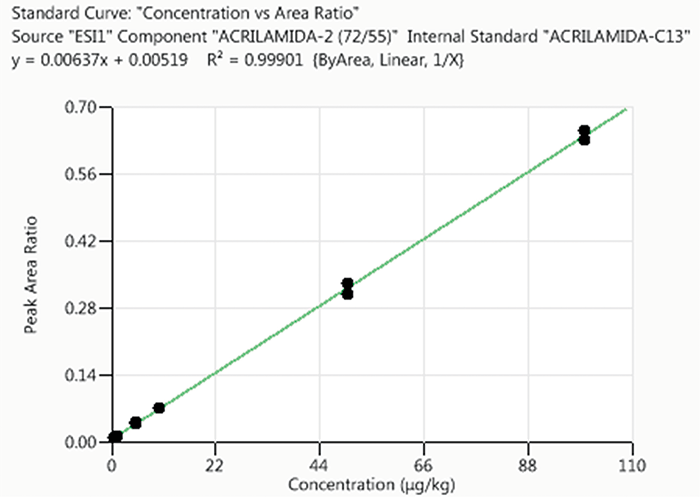Analysis of Acrylamide in Potato Chips by UHPLC–MS/MS
The Application Notebook
Acrylamide is viewed as a human health concern and found in certain foods after preparation or processing at high temperatures. World experts recommend reducing acrylamide in our diet and suggest long-term research studies to determine its potential risk. In this application we present an HPLC–MS/MS method for analysis of acrylamide in potato chips, using a simple sample preparation procedure.
Experimental Conditions
Stock solution of acrylamide (0.20 mg/mL) was prepared by dissolving 20 mg of the compounds in 100 mL of methanol. The standard working solutions were prepared by serial dilution sample; calibration levels were: 0.5–1.0–5.0–10–50–100 µg/L in methanol/water 50/50 and containing 100 µg/L of isotopic 13C-acrylamide. Samples were previously homogenized. Acrylamide extraction was as follows:
(1) Analytically weigh 1.0 ± 0.1 g crushed potato chips.
(2) Add 100 µL of 10 mg/L standard solution of 13C-acrylamide.
(3) Add 25 mL of 0.1% formic acid in methanol solution and mix in a shaker for 15 min.
(4) Centrifugation for 5 min (3000 rpm).
(5) Add 1 mL of extract to 1 mL of water.
(6) Condition C18 SPE tube (6 mL, 500 mg) with 2 mL methanol and 2 mL water/methanol 50/50: then, dry under vacuum.
(7) Apply 2 mL of extracted potato chip solution to SPE tube.
Acrylamide was separated on a PerkinElmer QSight® LX50 HPLC system using a UHPLC BEH C18 column (2.1 × 50 mm, 2.7 µm). Column temperature was set at 40 °C.

Figure 1: Linearity plot for standard solution over a range of 0.5-100 µg/L (internal standard).
Detection of acrylamide was carried out on a QSight triple quadrupole mass spectrometer equipped with an electrospray ionization source operating in positive ion mode and multiple reaction monitoring mode (MRM). Mass spectrometer conditions were as follows: ElectroSpray, 5000 V; Source Temp, 300 °C; HSID Temp, 275 °C; Drying Gas, 100 mL/min; Nebulizer Gas, 300 mL/min. Data acquisition and processing was performed using the Simplicity™ 3Q software.

Figure 2: MRM chromatogram of 0.5 and 5 µg/L acrylamide calibration solutions.
Results
The selectivity of the method was evaluated by adding a known concentration of acrylamide equivalent to the limit of quantification to a matrix target (25 µg/kg). No matrix effect was observed by comparing solvent solution and extract solutions (the variation of the mean of the responses of 10 trials between both samples was less than 10%). Matrix concentration in sample extracts is very low (20 mg/mL).
Based on the calculated LOQ of 25 µg/kg, this method was in compliance with the technical requirements set by Regulation (EU) 2017/2158 (recovery 75-110%, RSD < Horwitz modified, LOQ ≤ 50 µg/kg). Very good recoveries were obtained (from 85 to 109%).
Conclusions
The QSight triple quad provides a robust platform for the analysis of trace acrylamide levels in compliance with European Regulations. This rapid, sensitive, and reproducible method can also be applied to other types of regulated matrices such as bread, biscuits, breakfast cereals, and more.

PerkinElmer, Inc.
940 Winter Street, Waltham, MA 02451
tel. (781) 663-6900
Website: www.perkinelmer.com

New Study Reviews Chromatography Methods for Flavonoid Analysis
April 21st 2025Flavonoids are widely used metabolites that carry out various functions in different industries, such as food and cosmetics. Detecting, separating, and quantifying them in fruit species can be a complicated process.
Analytical Challenges in Measuring Migration from Food Contact Materials
November 2nd 2015Food contact materials contain low molecular weight additives and processing aids which can migrate into foods leading to trace levels of contamination. Food safety is ensured through regulations, comprising compositional controls and migration limits, which present a significant analytical challenge to the food industry to ensure compliance and demonstrate due diligence. Of the various analytical approaches, LC-MS/MS has proved to be an essential tool in monitoring migration of target compounds into foods, and more sophisticated approaches such as LC-high resolution MS (Orbitrap) are being increasingly used for untargeted analysis to monitor non-intentionally added substances. This podcast will provide an overview to this area, illustrated with various applications showing current approaches being employed.

.png&w=3840&q=75)

.png&w=3840&q=75)



.png&w=3840&q=75)



.png&w=3840&q=75)














